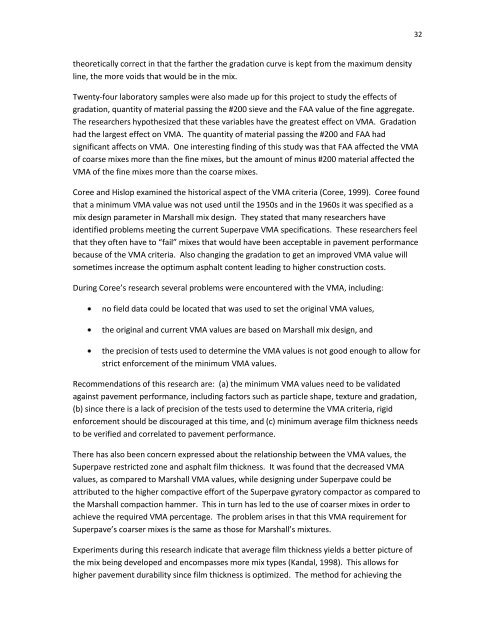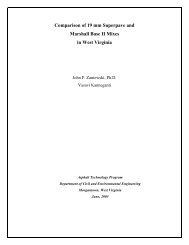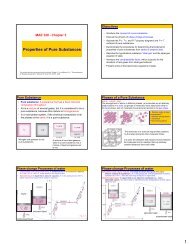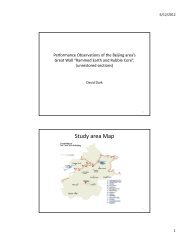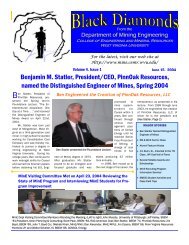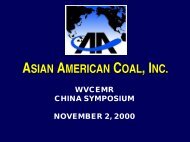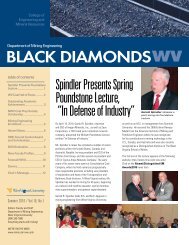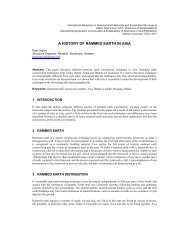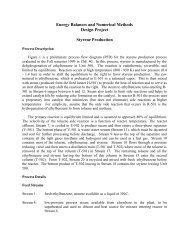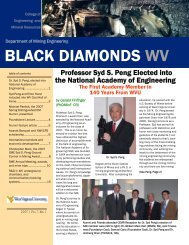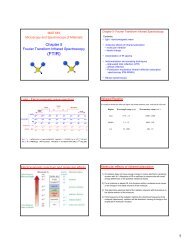Comparison of 9.5 mm SuperPave and Marshall Wearing I Mixes in ...
Comparison of 9.5 mm SuperPave and Marshall Wearing I Mixes in ...
Comparison of 9.5 mm SuperPave and Marshall Wearing I Mixes in ...
Create successful ePaper yourself
Turn your PDF publications into a flip-book with our unique Google optimized e-Paper software.
32theoretically correct <strong>in</strong> that the farther the gradation curve is kept from the maximum densityl<strong>in</strong>e, the more voids that would be <strong>in</strong> the mix.Twenty-four laboratory samples were also made up for this project to study the effects <strong>of</strong>gradation, quantity <strong>of</strong> material pass<strong>in</strong>g the #200 sieve <strong>and</strong> the FAA value <strong>of</strong> the f<strong>in</strong>e aggregate.The researchers hypothesized that these variables have the greatest effect on VMA. Gradationhad the largest effect on VMA. The quantity <strong>of</strong> material pass<strong>in</strong>g the #200 <strong>and</strong> FAA hadsignificant affects on VMA. One <strong>in</strong>terest<strong>in</strong>g f<strong>in</strong>d<strong>in</strong>g <strong>of</strong> this study was that FAA affected the VMA<strong>of</strong> coarse mixes more than the f<strong>in</strong>e mixes, but the amount <strong>of</strong> m<strong>in</strong>us #200 material affected theVMA <strong>of</strong> the f<strong>in</strong>e mixes more than the coarse mixes.Coree <strong>and</strong> Hislop exam<strong>in</strong>ed the historical aspect <strong>of</strong> the VMA criteria (Coree, 1999). Coree foundthat a m<strong>in</strong>imum VMA value was not used until the 1950s <strong>and</strong> <strong>in</strong> the 1960s it was specified as amix design parameter <strong>in</strong> <strong>Marshall</strong> mix design. They stated that many researchers haveidentified problems meet<strong>in</strong>g the current Superpave VMA specifications. These researchers feelthat they <strong>of</strong>ten have to “fail” mixes that would have been acceptable <strong>in</strong> pavement performancebecause <strong>of</strong> the VMA criteria. Also chang<strong>in</strong>g the gradation to get an improved VMA value willsometimes <strong>in</strong>crease the optimum asphalt content lead<strong>in</strong>g to higher construction costs.Dur<strong>in</strong>g Coree’s research several problems were encountered with the VMA, <strong>in</strong>clud<strong>in</strong>g:no field data could be located that was used to set the orig<strong>in</strong>al VMA values,the orig<strong>in</strong>al <strong>and</strong> current VMA values are based on <strong>Marshall</strong> mix design, <strong>and</strong>the precision <strong>of</strong> tests used to determ<strong>in</strong>e the VMA values is not good enough to allow forstrict enforcement <strong>of</strong> the m<strong>in</strong>imum VMA values.Reco<strong>mm</strong>endations <strong>of</strong> this research are: (a) the m<strong>in</strong>imum VMA values need to be validatedaga<strong>in</strong>st pavement performance, <strong>in</strong>clud<strong>in</strong>g factors such as particle shape, texture <strong>and</strong> gradation,(b) s<strong>in</strong>ce there is a lack <strong>of</strong> precision <strong>of</strong> the tests used to determ<strong>in</strong>e the VMA criteria, rigidenforcement should be discouraged at this time, <strong>and</strong> (c) m<strong>in</strong>imum average film thickness needsto be verified <strong>and</strong> correlated to pavement performance.There has also been concern expressed about the relationship between the VMA values, theSuperpave restricted zone <strong>and</strong> asphalt film thickness. It was found that the decreased VMAvalues, as compared to <strong>Marshall</strong> VMA values, while design<strong>in</strong>g under Superpave could beattributed to the higher compactive effort <strong>of</strong> the Superpave gyratory compactor as compared tothe <strong>Marshall</strong> compaction ha<strong>mm</strong>er. This <strong>in</strong> turn has led to the use <strong>of</strong> coarser mixes <strong>in</strong> order toachieve the required VMA percentage. The problem arises <strong>in</strong> that this VMA requirement forSuperpave’s coarser mixes is the same as those for <strong>Marshall</strong>’s mixtures.Experiments dur<strong>in</strong>g this research <strong>in</strong>dicate that average film thickness yields a better picture <strong>of</strong>the mix be<strong>in</strong>g developed <strong>and</strong> encompasses more mix types (K<strong>and</strong>al, 1998). This allows forhigher pavement durability s<strong>in</strong>ce film thickness is optimized. The method for achiev<strong>in</strong>g the


